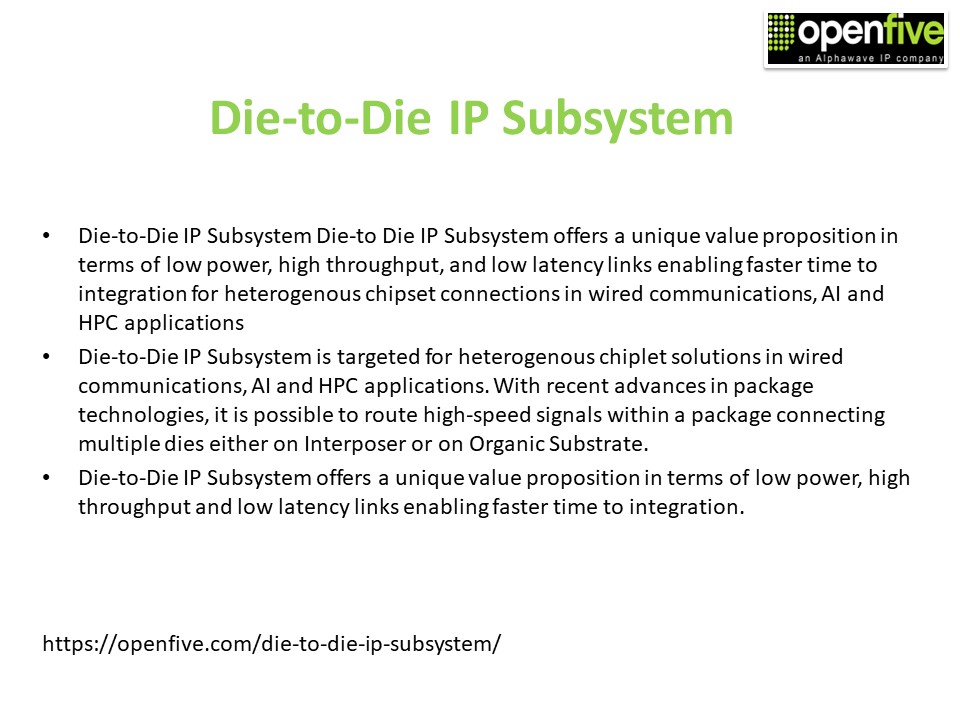Die-to-Die IP Subsystem-Die-to-Die Interposer I/O - PowerPoint PPT Presentation
Title:
Die-to-Die IP Subsystem-Die-to-Die Interposer I/O
Description:
Die-to-Die IP Subsystem Die-to Die IP Subsystem offers a unique value proposition in terms of low power, high throughput, and low latency links enabling faster time to integration for heterogenous chipset connections in wired communications, AI and HPC applications – PowerPoint PPT presentation
Number of Views:5
Title: Die-to-Die IP Subsystem-Die-to-Die Interposer I/O
1
Die-to-Die IP Subsystem
- Die-to-Die IP Subsystem Die-to Die IP Subsystem
offers a unique value proposition in terms of low
power, high throughput, and low latency links
enabling faster time to integration for
heterogenous chipset connections in wired
communications, AI and HPC applications - Die-to-Die IP Subsystem is targeted for
heterogenous chiplet solutions in wired
communications, AI and HPC applications. With
recent advances in package technologies, it is
possible to route high-speed signals within a
package connecting multiple dies either on
Interposer or on Organic Substrate. - Die-to-Die IP Subsystem offers a unique value
proposition in terms of low power, high
throughput and low latency links enabling faster
time to integration.
https//openfive.com/die-to-die-ip-subsystem/
2
Block Diagram
- Die-to-Die IP Subsystem is targeted for
heterogenous chiplet solutions in wired
communications, AI and HPC applications. With
recent advances in package technologies, it is
possible to route high-speed signals within a
package connecting multiple dies either on
Interposer or on Organic Substrate.
https//openfive.com/die-to-die-ip-subsystem/
3
D2D Controller IP
- D2D Controller IP Key Features
- Ultra-high-bandwidth and performance (For e.g.
1024-bit AXI interface at 2GHz can provide up to
2 Tbps) - Ultra-low latency including Tx and Rx depending
on the optional FEC module to improve BER - Support for the SerDes rates up to 112 Gbps
(CEI-112G-XSR) and aggregation support up to 48
lanes - Independent SerDes lane enable/disable and fully
programmable SerDes lane mapping - Flexible AXI interface options including 64b,
128b, 256b, 512b and 1024b - Optional In-band and Out-of-Band flow control
- Built-in error detection and interrupt structure
- Optional re-transmission module for error free
transmission - Configurable error injection mechanisms for
testability - Debug Features PRBS generators/checkers and
loopback support for both data and flow control
https//openfive.com/die-to-die-ip-subsystem/
4
D2D PHY IP
- D2D PHY IP Key Features
- D2D PHY signals are single ended (Single Duplex)
and are based on HBM Memory Electrical IOs - Each channel is made up of 42 pairs of Tx/Rx
signals that runs at configurable speed up to
16Gbps contributing up to 1.75Tbps/mm - Channel lengths support up to 5mm with latency
less than 5ns (Other combinations are available) - Best in the industry less than 0.5 pJ/bit power
consumption - Built-in PLL to support differential clock
forwarding - Self-contained initialization and calibration
state machines - No requirement of Forward Error Correction (FEC)
IP as signal supports channel BER up to 1E-21 - Programmable output drivers
- Compatible to various parallel wire specification
in the industry
https//openfive.com/die-to-die-ip-subsystem/
5
- Please do visit my website for
- in-depth information.
- Website
- https//openfive.com/die-to-die-ip-subsystem/































